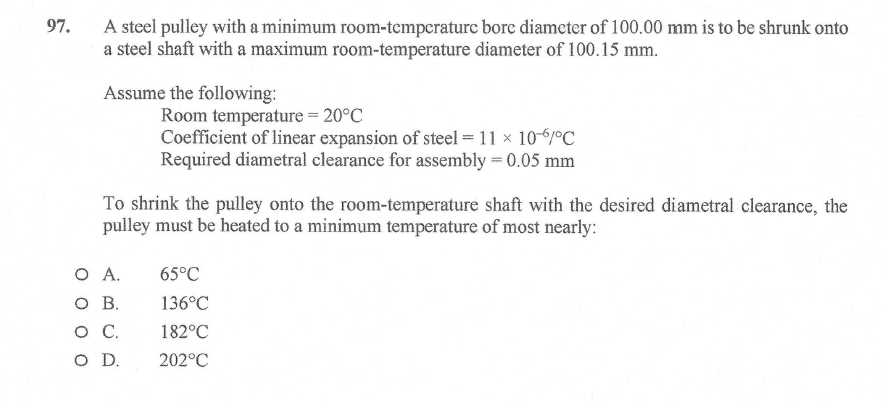A steel pulley with a minimum room-temperature bore diameter of 100.00 mm is to be shrunk onto a steel shaft with a maximum room-temperature diameter of 100.15 mm. Assume the following: Room temperature = 20°C Coefficient of linear expansion of steel = 11 x 10-6°C Required diametral clearance for assembly = 0.05 mm To shrink the pulley onto the room-temperature shaft with the desired diametral clearance, the pulley must be heated to a minimum temperature of most nearly:
A steel pulley with a minimum room-temperature bore diameter of 100.00 mm is to be shrunk onto a steel shaft with a maximum room-temperature diameter of 100.15 mm. Assume the following: Room temperature = 20°C Coefficient of linear expansion of steel = 11 x 10-6°C Required diametral clearance for assembly = 0.05 mm To shrink the pulley onto the room-temperature shaft with the desired diametral clearance, the pulley must be heated to a minimum temperature of most nearly:
Elements Of Electromagnetics
7th Edition
ISBN:9780190698614
Author:Sadiku, Matthew N. O.
Publisher:Sadiku, Matthew N. O.
ChapterMA: Math Assessment
Section: Chapter Questions
Problem 1.1MA
Related questions
Question
Please answer question with as much detail as possible
Please Use the “NCEES FE Reference Handbook 10.0.1” which can be downloaded for Free from https://ncees.org/ as your Reference for tables and formulas

Transcribed Image Text:97.
A steel pulley with a minimum room-temperature bore diameter of 100.00 mm is to be shrunk onto
a steel shaft with a maximum room-temperature diameter of 100.15 mm.
Assume the following:
Room temperature = 20°C
Coefficient of linear expansion of steel = 11 x 10-6°C
Required diametral clearance for assembly = 0.05 mm
To shrink the pulley onto the room-temperature shaft with the desired diametral clearance, the
pulley must be heated to a minimum temperature of most nearly:
O A.
O B.
65°C
136°C
о с.
182°C
D.
202°C
Expert Solution
This question has been solved!
Explore an expertly crafted, step-by-step solution for a thorough understanding of key concepts.
This is a popular solution!
Trending now
This is a popular solution!
Step by step
Solved in 2 steps with 2 images

Knowledge Booster
Learn more about
Need a deep-dive on the concept behind this application? Look no further. Learn more about this topic, mechanical-engineering and related others by exploring similar questions and additional content below.Recommended textbooks for you

Elements Of Electromagnetics
Mechanical Engineering
ISBN:
9780190698614
Author:
Sadiku, Matthew N. O.
Publisher:
Oxford University Press

Mechanics of Materials (10th Edition)
Mechanical Engineering
ISBN:
9780134319650
Author:
Russell C. Hibbeler
Publisher:
PEARSON

Thermodynamics: An Engineering Approach
Mechanical Engineering
ISBN:
9781259822674
Author:
Yunus A. Cengel Dr., Michael A. Boles
Publisher:
McGraw-Hill Education

Elements Of Electromagnetics
Mechanical Engineering
ISBN:
9780190698614
Author:
Sadiku, Matthew N. O.
Publisher:
Oxford University Press

Mechanics of Materials (10th Edition)
Mechanical Engineering
ISBN:
9780134319650
Author:
Russell C. Hibbeler
Publisher:
PEARSON

Thermodynamics: An Engineering Approach
Mechanical Engineering
ISBN:
9781259822674
Author:
Yunus A. Cengel Dr., Michael A. Boles
Publisher:
McGraw-Hill Education

Control Systems Engineering
Mechanical Engineering
ISBN:
9781118170519
Author:
Norman S. Nise
Publisher:
WILEY

Mechanics of Materials (MindTap Course List)
Mechanical Engineering
ISBN:
9781337093347
Author:
Barry J. Goodno, James M. Gere
Publisher:
Cengage Learning

Engineering Mechanics: Statics
Mechanical Engineering
ISBN:
9781118807330
Author:
James L. Meriam, L. G. Kraige, J. N. Bolton
Publisher:
WILEY